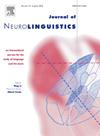A γ operational workspace for syntax in L1 and L2 processing: evidence from recursive re-representations of wh-fillers in French
IF 1.2
3区 心理学
Q2 LINGUISTICS
引用次数: 0
Abstract
Recent theoretical proposals identify cortical gamma (γ) oscillations as signaling a mechanistic γ operational workspace (e.g., Murphy, 2024). Following the hypothesis that first (L1) and second (L2) languages involve shared neurofunctional mechanisms (Green & Abutalebi, 2008), we document cortical γ oscillatory dynamics in processing wh-filler-gap dependencies across a clause edge such as ‘Which decision regarding/about him did Paul say that Lydie had rejected without hesitation?’ in L1 and L2 French using electroencephalography. We manipulated wh-filler grammatical specifications with modifiers (Mods) vs. lexically specified complements (Comps) and with pronouns marked for antecedent gender or not. We used cluster-based non-parametric permutation tests (Oostenveld et al., 2011) in an analysis window covering ‘said that’ in two bins: 30–100Hz (broadband γ) and 30–50Hz (low γ). Event-related power differences (ERPDs) showed greater power for Comps than Mods and for antecedent-gender-specified than gender-unspecified Comps across L1 and L2. Narrowband/low-γ effects started in advance of bridge verb access and were maintained after verb access into the subordinator. These significant effects were echoed by broadband-γ ERPDs timed with the verb and subordinator, suggesting output activity in object creation. Two bursts of between-group ERPDs in low and broadband γ, respectively, reflected the (lack of) antecedent-gender specification of pronouns in anaphora relations. Hence, these patterns of oscillatory dynamics suggest that similarities and differences between L1 and L2 are accounted for by a γ-implemented operational workspace (Murphy, 2024) that enables the creation of structural and referential chain objects (Dekydtspotter et al., 2024).
L1和L2处理中语法的γ操作工作区:来自法语中wh填充符递归再现的证据
最近的理论建议认为皮质γ振荡是一个机制γ操作工作空间的信号(例如,Murphy, 2024)。假设第一语言(L1)和第二语言(L2)涉及共享的神经功能机制(Green &;Abutalebi, 2008),我们记录了大脑皮层γ振荡动力学在处理跨子句边缘(如“关于他,保罗说过的哪个决定被Lydie毫不犹豫地拒绝了?”在L1和L2法语中使用脑电图。我们用修饰语(Mods)和词法上指定的补语(Comps)以及代词标记先行词性别或不标记先行词性别来操纵填充词的语法规范。我们在一个分析窗口中使用了基于聚类的非参数排列测试(oostenvelope等人,2011年),该分析窗口覆盖了两个箱子中的“said”:30-100Hz(宽带γ)和30-50Hz(低γ)。事件相关功率差异(erpd)显示,在第一、二语言中,事件相关功率差异在比较中高于mod,在前词性别指定的比较中高于非性别指定的比较。窄带/低γ效应在桥接动词进入之前开始,并在动词进入从属体后维持。这些显著的影响在与动词和从属词同步的宽频γ erpd中得到了回应,表明在对象创建中有输出活动。组间erpd分别在低γ和宽带γ区域爆发,反映了指代关系中代词的先行性别规范(缺乏)。因此,这些振荡动力学模式表明,L1和L2之间的相似性和差异是由γ实现的操作工作空间(Murphy, 2024)来解释的,该工作空间能够创建结构和参考链对象(Dekydtspotter等人,2024)。
本文章由计算机程序翻译,如有差异,请以英文原文为准。
求助全文
约1分钟内获得全文
求助全文
来源期刊

Journal of Neurolinguistics
医学-神经科学
CiteScore
3.90
自引率
5.00%
发文量
49
审稿时长
17.2 weeks
期刊介绍:
The Journal of Neurolinguistics is an international forum for the integration of the neurosciences and language sciences. JNL provides for rapid publication of novel, peer-reviewed research into the interaction between language, communication and brain processes. The focus is on rigorous studies of an empirical or theoretical nature and which make an original contribution to our knowledge about the involvement of the nervous system in communication and its breakdowns. Contributions from neurology, communication disorders, linguistics, neuropsychology and cognitive science in general are welcome. Published articles will typically address issues relating some aspect of language or speech function to its neurological substrates with clear theoretical import. Interdisciplinary work on any aspect of the biological foundations of language and its disorders resulting from brain damage is encouraged. Studies of normal subjects, with clear reference to brain functions, are appropriate. Group-studies on well defined samples and case studies with well documented lesion or nervous system dysfunction are acceptable. The journal is open to empirical reports and review articles. Special issues on aspects of the relation between language and the structure and function of the nervous system are also welcome.
 求助内容:
求助内容: 应助结果提醒方式:
应助结果提醒方式:


